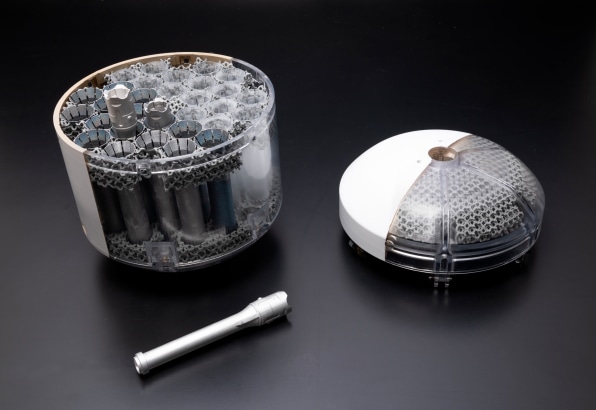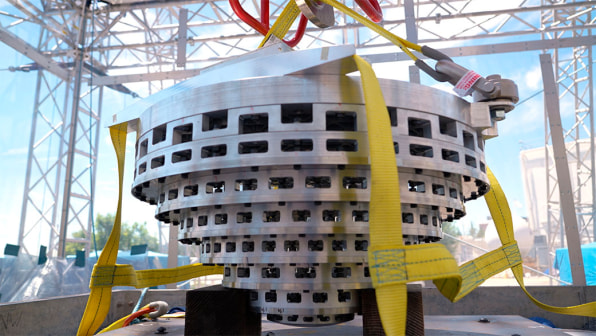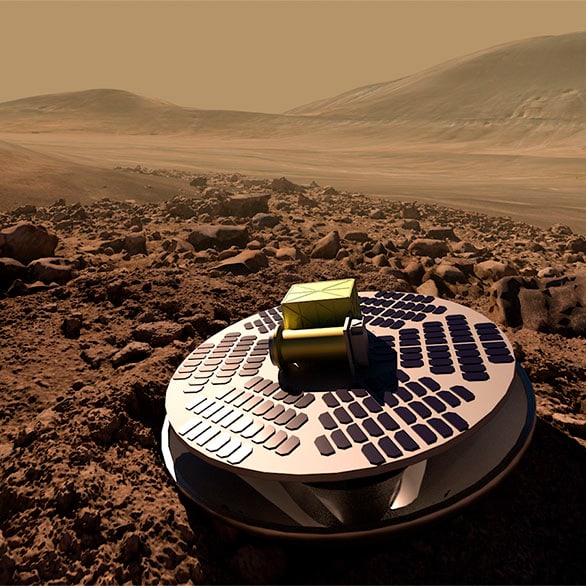7.02.2023
On purpose. NASA’s crash-landing design will someday enable swarms of small rovers to explore planets like never before.

Illustration: California Academy of Sciences/courtesy NASA
Ever since humans dwelled in caves, we’ve never stopped wondering about the glowing clockwork that lights up the night sky. Our brains, made of the same star-stuff that shapes this cosmic dance, reach out in search for answers to questions fundamental to our very existence. This desire to know the why, where, and how we came to be is only shackled by the limited resources that politicians allocate to this quest. Budget limitations only allow for a handful of spaceships that traverse the solar system every decade. Thus, the worlds that may give us all the answers to the how and why we came to be feel forever at arm’s length, never within our embrace. Fortunately, this might soon change thanks to a new ingenious device designed at NASA’s Jet Propulsion Laboratory in Pasadena, California.
SHIELD—an acronym for Simplified High Impact Energy Landing Device—is a new kind of landing gear designed to enable spaceships that could crash-land on any planet or moon as long as it has an atmosphere. The mechanism achieves this by getting rid of entry, descent, and landing(EDL) mechanisms—some of the heaviest and most expensive parts required to send a robot to closely study planets—and replacing them with a crushable conical accordion capable of absorbing the kinetic energy of the extremely violent impact against the planet’s surface. “It works a lot like an automotive crumple zone,” as SHIELD’s project’s manager Lou Giersch tells me in an interview over videoconference.
These SHIELD-equipped space vehicles will be much nimbler, simpler, and cheaper than the current generation of rovers, so much so that they could empower swarms of robots to land on martian planets. These swarms could enable more frequent missions to explore our solar neighborhood continuously, redundantly, and without fear of failure. If it works as expected, SHIELD could be the harbinger of a new space exploration age.
A BRIEF HISTORY OF LANDING SYSTEMS
Historically, NASA’s explorers have used a variety of methods to land on martian destinations. All of them were complex, expensive, and one mistake away from failure. Mars’ missions are a perfect example of those challenges. Spaceships must survive the planet’s atmospheric friction that could melt them away as they slow down from more than 10,000 miles-per-hour to zero. Along the way, they have to deploy parachutes and retrorockets with the precision of a Swiss watch while frantically searching for flat terrain free of large boulders or holes where they can land. Humans do not pilot these things. It’s no wonder that 10 out of 21 Mars landers have failed to complete their mission.
The Viking 1 was the first explorer to arrive on Mars in 1980. It was a 1,261-pound triangular scientific platform with three legs that measured 6 x 12 x 10 feet. It first used a heat shell, then a parachute to slow it down, and finally retrorockets to land itself.
Seventeen years later, the 793-pound Pathfinder roverfamously plunged into Mars’ atmosphere swathed in a cocoon of giant spherical airbags. Protecting the rover was a capsule whose descent was slowed by a series of sophisticated design interventions: first, a heat shield, then a parachute, and finally a pack of retrorockets, which fired at around 225 feet above the ground. At 100 feet, the rocket pack cut the line that held the pneumatic cocoon, and it fell to Mars’ surface before bouncing 16 times and finally stopping two minutes later at a random point in Ares Vallis, a Martian outflow channel that scientists suspect may have been carved by water.
Though the Pathfinder’s landing system worked, NASA had to design a new method to land Curiosity: the airbag method wouldn’t be able to safely land this six-wheel robot, which is as large as a Volkswagen Beetle and weighs 1,982 pounds. Curiosity’s landing system was exponentially more complex than any other in the history of NASA. In fact, the design was so complicated that the space agency made a video outlining exactly how it could all go very wrong—from the first-of-its-kind hypersonic parachute to the floating sky crane that gently placed the rover on the planet’s surface. After cleanly landing the vehicle on the Martian crust, the crane used pyrotechnic charges to sever the cables before thrusting itself as far as it could from Curiosity.
The process had multiple potential points of failure, but it worked: twice, actually, repeating the feat with Perseverance in 2021. As Curiosity’s EDL lead engineer Adam Steltzner told me in an interview at JPL the day after the rover landed, it looks crazy, but “it’s one of the greatest landing systems [NASA] has ever designed.”
THE POWER OF SIMPLICITY
SHIELD is simpler and less expensive than NASA’s previous landing systems, but it’s no less ingenious. Instead of using parachutes, airbags, retrorockets, or sky cranes, a spaceship equipped with SHIELD will enter an atmosphere at full speed on a “low-ballistic-coefficient trajectory,” slowed only by atmospheric friction. The spaceship will then crash against the surface of planets and moons. And that’s it. Once on the ground, the probe will power up its science instruments and perhaps even deploy a small rover or a flying machine, like a real-life version of the Imperial probe that hit Hoth’s surfacesearching for rebels in The Empire Strikes Back.

Giersch says he and his colleagues got the inspiration for SHIELD while working as part of a support team in the design of the Mars Sample Return (MSR) mission, which will send Martian rocks to Earth in 2033. The MSR lander will go to the red planet in order to pick up the samples taken by the Perseverance rover and send them to Earth inside a capsule for analysis. This capsule will crash on Earth. “It’s going to land in the [Department of Defense’s] Utah Test and Training Range, which is this really big area where the ground is relatively soft,” Giersch says. Soft enough, he says, to absorb the kinetic energy of the small capsule, so it could survive the impact.
As Giersch and his colleagues studied the Utah terrain, they started to think that perhaps they could crash scientific probes on other planets. This was a crazy concept because the assumption has always been that spaceships need a very soft landing, with very low deceleration, to preserve their electronic and mechanical systems. But, as Giersch tells me, a typical SHIELD vehicle will experience a sudden deceleration of around 1,000 to 2,000 G on impact. That’s enough to liquify a human on impact or shatter any mechanics or electronics into a zillion pieces. On top of that, scientists don’t really know which kind of terrain a crash-landing vehicle could encounter on other planets. It could be as soft as Utah’s or it could be rock-hard.

That’s when they came up with the idea of the crash absorption system, Giersch tells me. From the outside, the SHIELD system is simple and elegant. It looks like a cone made of concentric, cylindrical metal segments nested over each other. The widest segment holds the scientific payload while the narrowest part is what hits the planet first. As SHIELD crashes against the surface, these segments begin to collapse onto each other, absorbing and dissipating the energy from the crash as the structure deforms. “When we hit the ground, it crumples up and decelerates the vehicle, limiting the peak forces that the lander experiences to something that we think electronics can handle,” Giersch says.
The system works. “The latest test went really well,” Giersch tells me. “It hit the ground at 131 feet per second and it dissipated about 98% of all the kinetic energy. We had previously done another test with a smaller version of SHIELD at 164 feet per second, our full speed landing on Mars.” So far, all their tests have worked out perfectly.
Aside from the scientific instruments that measured the test—like an accelerometer—the team also placed a consumer smartphone inside the lander to see if it could survive. After the test, it worked without a glitch. This gives the team confidence that SHIELD is a solid technology, but there’s still much work to do before it’s ready for launch. Right now, Giersch’s team at JPL is working with collaborators at NASA’s Ames and Langley Research Centers to mature the SHIELD lander design. At the same time, NASA’s engineers are working with the science community to identify instrument payloads that can leverage SHIELD technology to create compelling, low-cost mission concepts.
Giersch is excited about the possibilities of that eventual martian research. He believes the mass of a SHIELD lander will max out at 440 pounds, about a fourth of a Curiosity rover. Anything heavier than that will carry too much kinetic energy for the SHIELD system to absorb on impact. Much of that weight is the crumpling zone, batteries, and the electronic systems to support the mission, leaving about 44 pounds for science payload that can be used for various missions. That’s enough mass to include plenty of scientific instruments, and even deploy small rovers and helicopters, which could further explore the terrain around the lander.
Chad Edwards, who leads the Advanced Studies Office at JPL’s Mars Program, says that although total cost analysis hasn’t been completed yet, a SHIELD lander mission could be accomplished at 10-20% of the cost of previous soft-landing Mars missions like Curiosity. So while he believes that SHIELD vehicles will not replace the larger rovers, “the availability of this technology can open the door for much lower-cost, more frequent access to the Martian surface for novel science investigations, including multi-lander distributed networks.”
A NEW SPACE AGE
Astrophysicist Avi Loeb believes that SHIELD is “an excellent idea.” Loeb, a professor of astrophysics at Harvard University and the director of the Institute for Theory and Computation at the Harvard-Smithsonian Center for Astrophysics, is a big proponent of the idea of distributed space exploration that SHIELD is bringing. In fact, he cofounded the Copernicus Space Corporation, an organization that aims to build infrastructure to support space exploration across the solar system using swarms of small, redundant spaceships.
Loeb’s vision proposes a path for space exploration that deviates from the “large, expensive, and often-crewed missions.” He believes technology is now at a point in which we can use swarms of numerous small, cheap, autonomous, potentially artificially intelligent probes. “A swarm of miniprobes could visit many interesting sites in the atmosphere, and on or below the surface of planets or moons in retrieving important scientific information, and in searching for extraterrestrial life in the solar system, and later in our galactic neighborhood.”

Crucially, a swarm approach reduces the pressure on a single rover to perform. “There’s the statistical robustness of a system where, if you lose one or two [spacecraft], you don’t really care because you’ve got so many others that can still complete the science objectives.” NASA rovers are time-consuming and costly to build—Perseverance, for example, cost $2.7 billion to build and launch. Losing a rover like that would be a devastating blow not only to American taxpayers but to the scientific community.
A design like SHIELD also enables NASA to send a rover to risky locations that might provide invaluable data if successful. “Maybe we’re willing to risk a hundred million dollar rover to go somewhere that’s really, really exciting, but dangerous in terms of the landing environment,” Giersch says. Places like Valles Marineris, the deepest canyon in the solar system that runs across Mars’ equator.
Because, as Giersch points out, truly understanding a complex system like an entire world requires scaling up research—just like how we study Earth using multiple satellites and ground stations. “If you have lots of different landers, you can learn so much more by measuring an event from different places,” he says.
SHIELD’s swarm philosophy holds the promise of a deeper knowledge of our existence just around the corner and a new path for humanity in the distant future, as Loeb pointed out in a column a few weeks ago: “Eventually, the merging of nanotechnology and synthetic biology [in this swarm probes] will enable us to consider seeding terrestrial life in our galaxy, as well as carrying Earth’s and our human legacy to space for preservation over billions of years.” We are far from that but, for now, this is a path too exciting and powerful to ignore. Our destiny awaits.
Quelle: FASTCOMPANY
